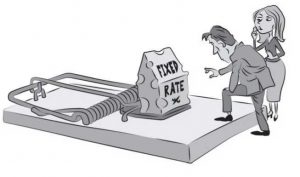One of the main choices you need to make early on is whether to opt for a variable or fixed rate loan.
In general, if your goal is becoming mortgage free faster, a variable rate loan is a better option. Everyone needs to assess their needs on a case- by-case basis, but in general, the flexibility of a variable loan has the advantages of allowing us to more easily refinance to a better deal, and more options for extra repayments.
Having said this, some lenders offer fixed rates with an Offset Account, which I will detail the advantages and proper use of later in this book. A fixed rate loan with an Offset Account effectively does allow you to make extra repayments, but you still can’t pay the loan out entirely without incurring break fees.
Be careful with fixed-rate loans
Fixed rates are generally based on what the economy is expected to do over the next few years, while variable rates are more aligned to the current cash rate, set by the Reserve Bank of Australia.
So if fixed rates are lower than variable rates the banks are expecting interest rates to fall. Therefore if the bank’s highly paid economic forecasters are right, then fixing won’t benefit you because variable rates will drop anyway.
Conversely, when fixed rates are higher than variable rates the banks are expecting interest rates to rise. So again, if the bank’s economists are right, then fixing still won’t benefit you because you had to take a higher fixed rate as rates rose.
Also, the longer the fixed rate term the higher the rate. This is because the further into the future you look the more difficult it is to predict the economy. So the banks build themselves in a greater safety margin.
For these reasons borrowers are on average usually worse off when they fix rates. Of course, not always, and you need to look at how the specific loan offer compares and your personal situation, but in general the odds are against you saving money over the long term by fixing your rate.
There are reasons for taking out a fixed loan, but I’d recommend against doing it on the basis of predicting where interest rates are going. Even if you do pick it right and rates rise, you will only have a temporary reprieve until the fixed rate expires. And what often happens then is that you fix again at the higher rate, then variable rates fall and you lose out.
Of course, the decision between fixed and variable should take into account your personal situation and you should make up your own mind. Interest rates will fluctuate and you need to be confident you can afford higher rates if they rise.
Where fixed rates are useful is that they allow certainty in terms of repayments and can give you confidence when you feel you can’t afford a rate increase. So they do have their place in the right circumstances. But as a method for becoming mortgage free faster, I believe they bring too many restrictions.
Valuable Resource: guide to loan types
For a more detailed look at the different types of loans and their pro’s and con’s, download my free loan guide from the following website:

